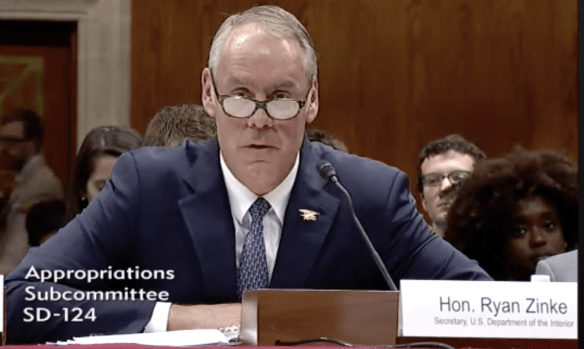For immediate release:
Public outraged killing and sales to slaughter is proposed by Zinke
WASHINGTON (June 21, 2017)–With no accurate head count of wild horses in the wild, the new Secretary of Interior, Ryan Zinke, pushes forward in the Senate tomorrow to lift the ban on destroying wild horses and unlimited sales by the truckload. Sales in the past of thousands of wild horses have resulted in America’s mustangs being slaughterd for a delicacy meal abroad. Protect Mustangs is petitioning for a Congressional investigation and head count of wild horses and burros (https://www.change.org/p/u-s-senate-investigate-the-wild-horse-burro-count-in-captivity-and-freedom) to find out how many are left and how many have already disappeared.
“The wild horse management responsibility of the Department of the Interior’s Bureau of Land Management mandates an accurate population count”, states Christine DeCarlo, PhD. “This is the only moral and legal way forward. Without that data any proposal can not be justified. A DNA study is warranted but just counting noses at this point would be a huge step in the right direction.”
“It’s time for the truth to come out before America’s last herds of wild horses are managed to extinction through killing, sterilization, sales by the truckload or pesticides used for birth control,” states Anne Novak, executive director of Protect Mustangs. “The bottom line is Americans want their wild horses protected. Count them first, then base management on accurate information, not hype.”
“We need an independent professional census done of all the wild horses and wild burros who remain upon the BLM and US Forest Service lands in and around their legal Herd Areas (BLM) and Territories (U.S. Forest Service),” explains Craig Downer, wildlife ecologist, Ph.D c. “I recognize that the situation is urgent, because this year I have been out in the field observing a number of the wild horse and wild burro herds, and am finding very few left.”
Pesticide PZP, made from slaughterhouse pig ovaries, and other forms of fertility control, is being pushed as a solution to the fake overpopulation problem. Without a head count of wild horses in the wild, basic information needed is ignored. Why has the bureau avoided head counts in the wild? Is it because the decline in population and the risk to herd survival would be exposed?
“When we include birth controls, such as Pesticide PZP, we have simply added yet another layer to the ‘Road to Extinction'”, states John Cox, veteran, author and nature photographer. “We go to ecological zones that are being destroyed, with low viability wildlife census populations, essentially going extinct (i.e. wild horses et al.) — then we go to diminishing lands-based parameters that require diversity, but there is only an estimated 4% of those lands left, which creates extinction of both wildlife and vegetation and yet another chain of extinction that exists yet ignored — then we go to the strata of different local areas, and the difference in census populations of wildlife, which creates different situations (one size does not fit all) and we find problems in both lands-mass as well as very low or next to no population viability.”
The National Academy of Sciences stated in their 2013 report (https://www.nap.edu/catalog/13511/using-science-to-improve-the-blm-wild-horse-and-burro-program) that there was “no evidence of overpopulation”. Since then the Department of Interior and the Bureau of Land Management have continued to spend millions on roundups and off-range holding based on inflated population estimates to fund their program.
Novak’s #NoKill Mustangs petition has more than 223,000 signatures: http://www.thepetitionsite.com/907/592/301/demand-nokill-45000-wild-horses-burros-in-holding/
Protect Mustangs’ Defund the Roundups and Stop the Slaughter Petition has more than 106,000 Signatures: https://www.change.org/p/defund-and-stop-the-wild-horse-burro-roundups
“Overpopulation is fake news,” says Novak. “We won’t let them kill wild horses, use pesticides on them or sell them to slaughter buyers. Wild horses aren’t pests or a meat source–they are national treasures and icons of freedom. The public is outraged.”
# # #
Links of Interest:
Live hearing June 22, 2017: https://naturalresources.house.gov/calendar/eventsingle.aspx?EventID=402138
Committee Hearing Notice: https://naturalresources.house.gov/uploadedfiles/hearing_notice_–_ov_hrg_06.22.17.pdf
Pesticide PZP Fact Sheet: https://www3.epa.gov/pesticides/chem_search/reg_actions/pending/fs_PC-176603_01-Jan-12.pdf
Dangers of PZP: http://protectmustangs.org/?page_id=6922
Media Contacts:
Anne Novak: Tel./Text: 415.531.8454, Anne@ProtectMustangs.org
Twitter: https://twitter.com/TheAnneNovak
Facebook: https://www.facebook.com/ProtectMustangs
Stephanie Allen: Tel./Text: 414.544.2015, sallenicrofwi@gmail.com
Protect Mustangs is a 501(c)3 nonprofit organization dedicated to the protection and preservation of native and wild horses. www.ProtectMustangs.org




